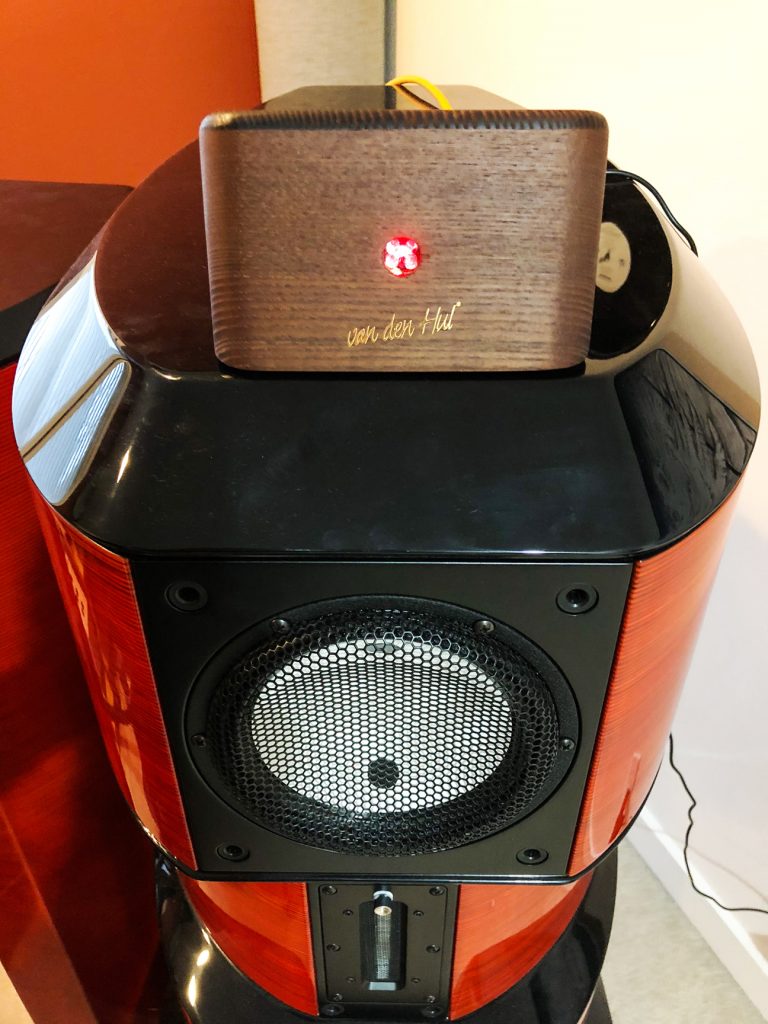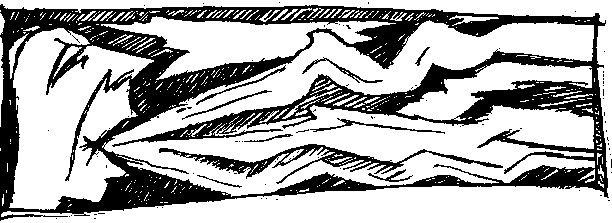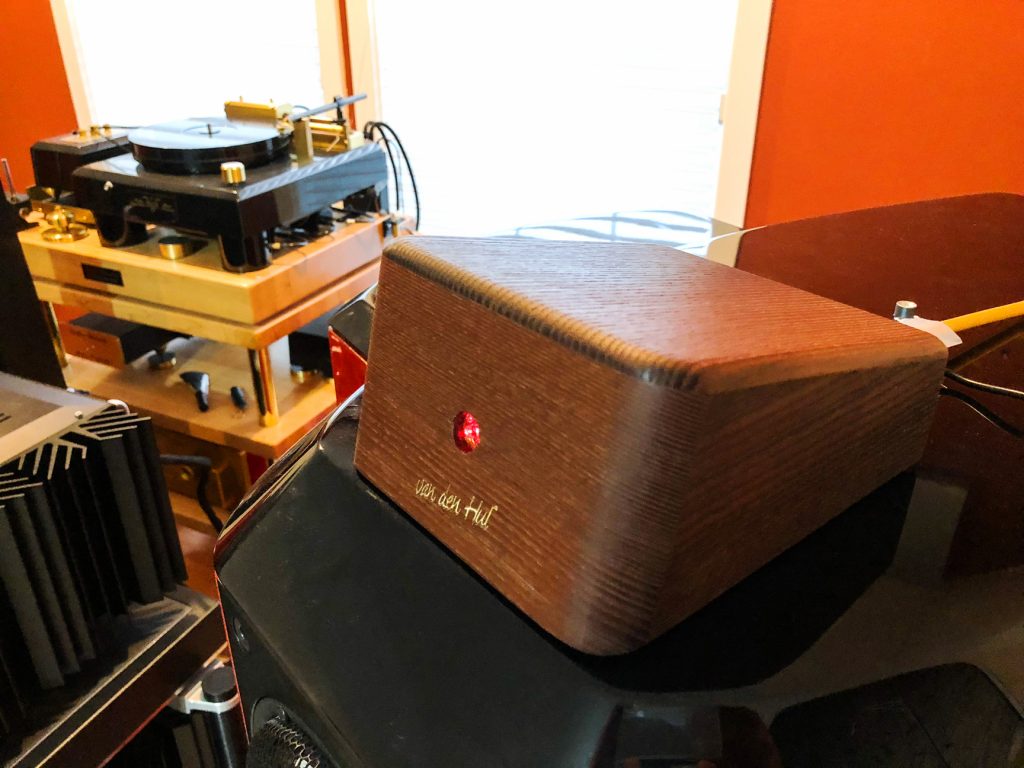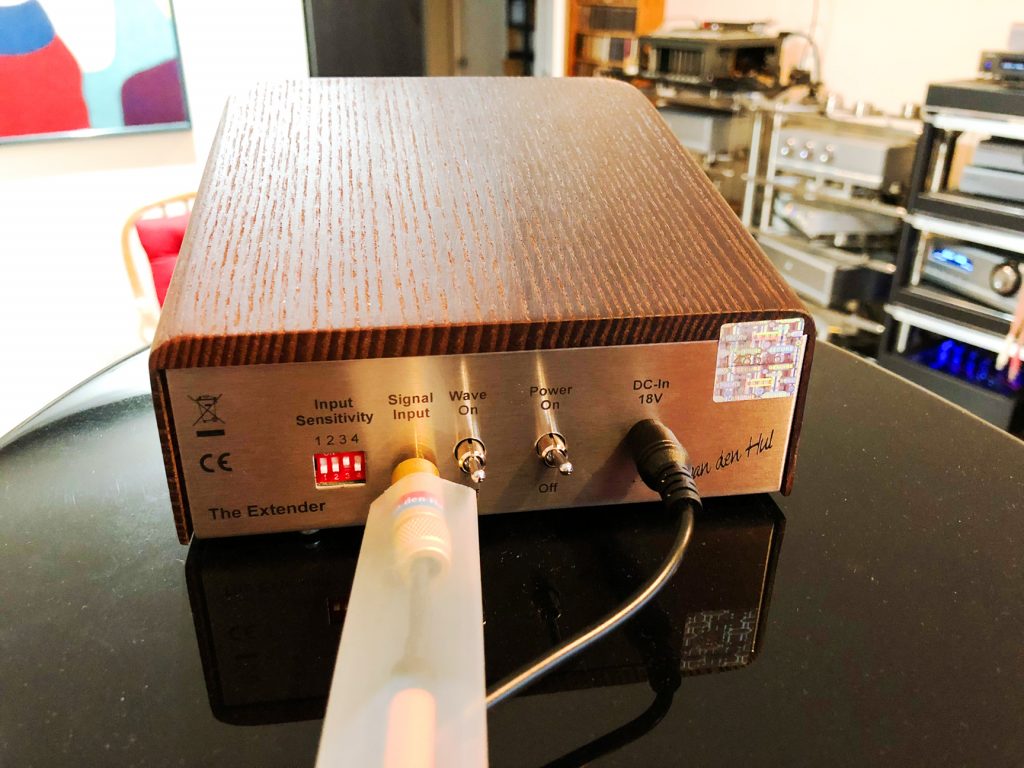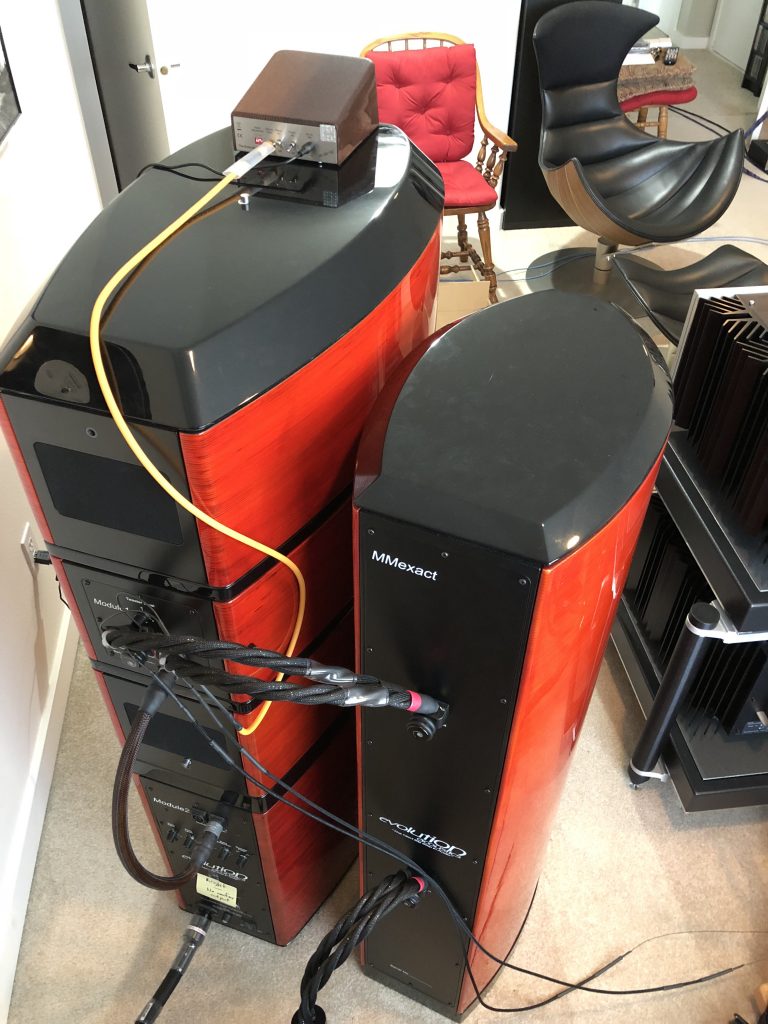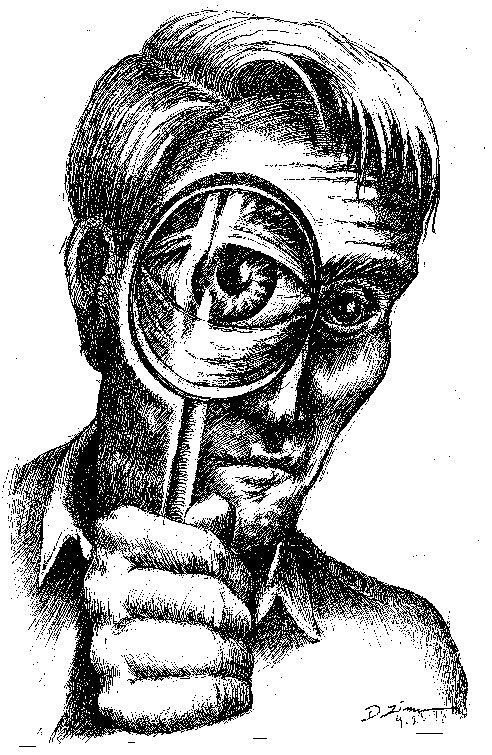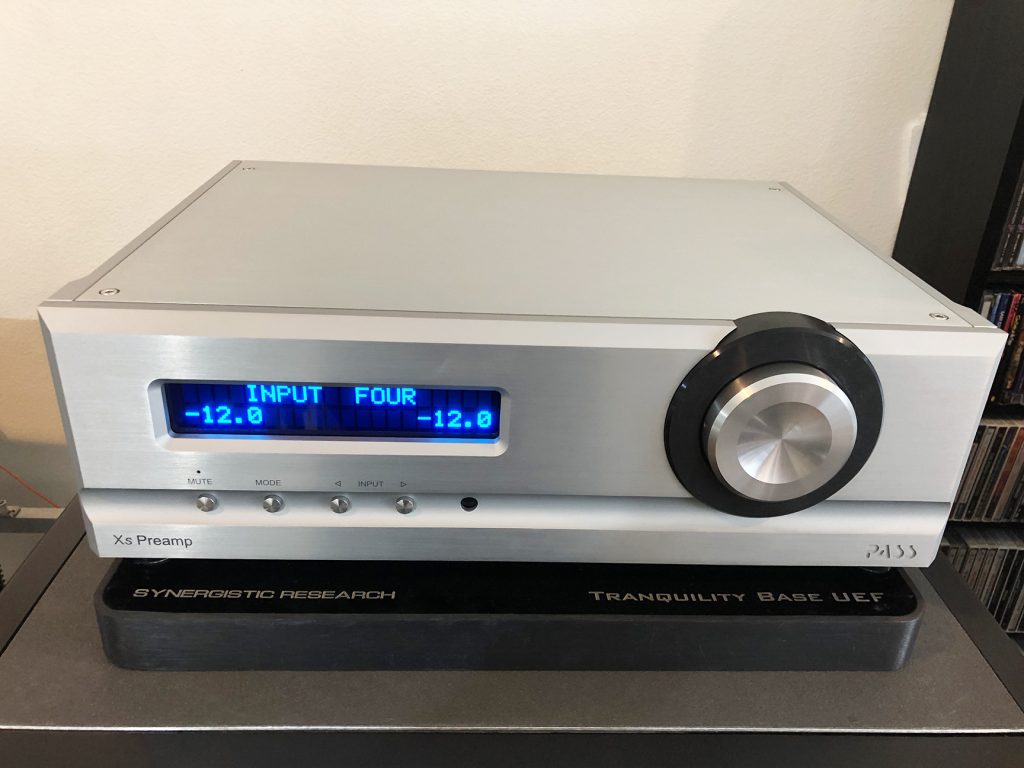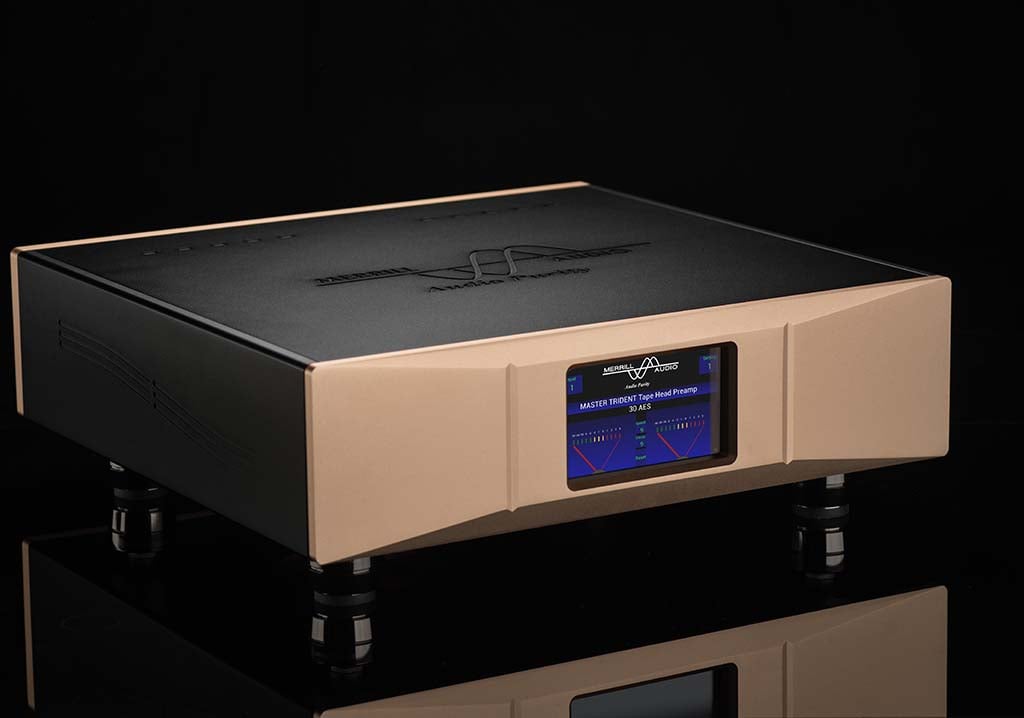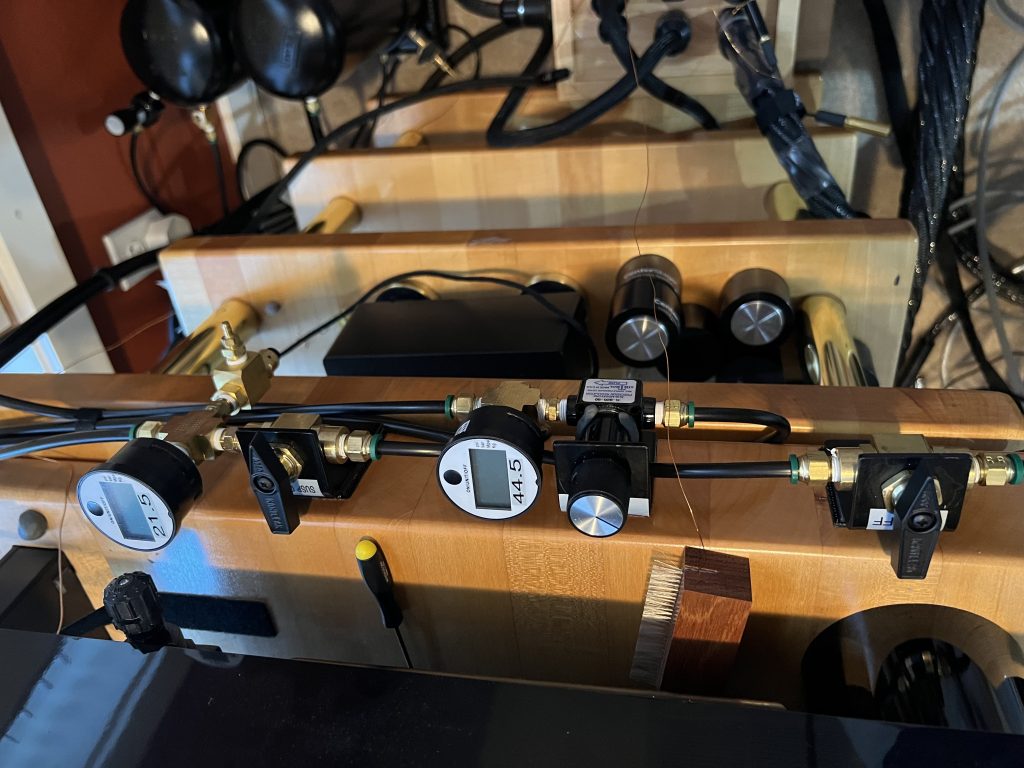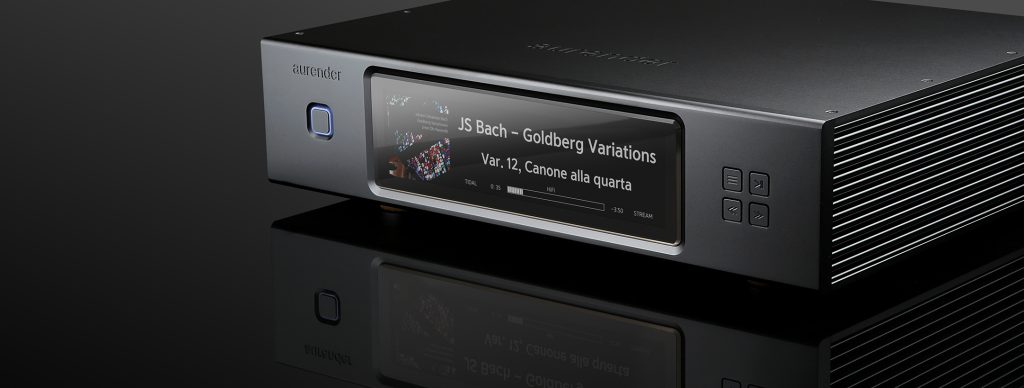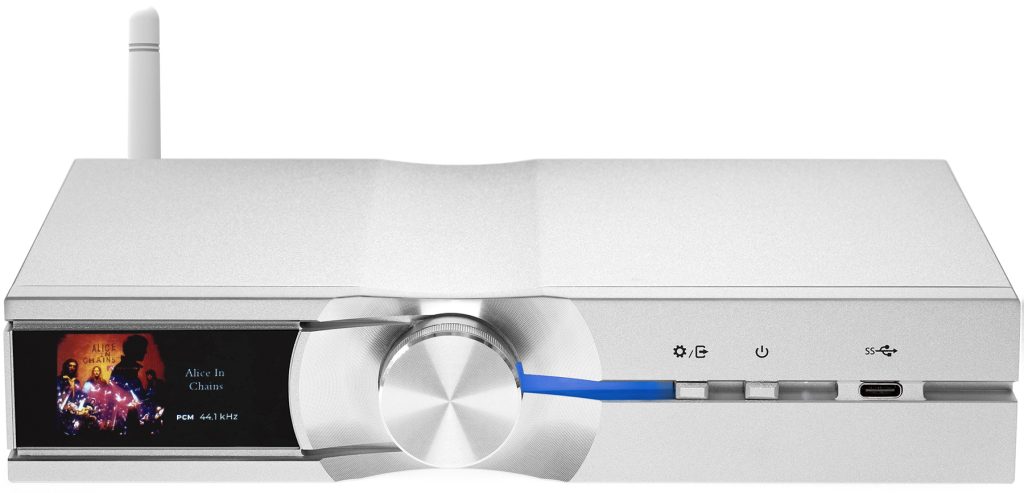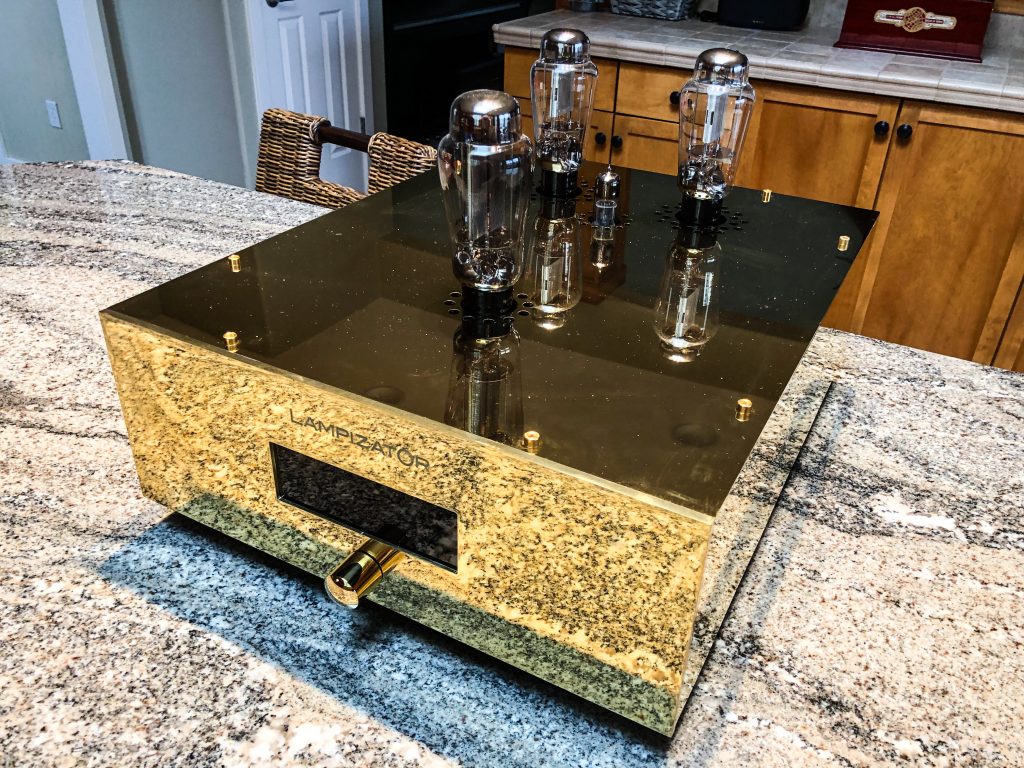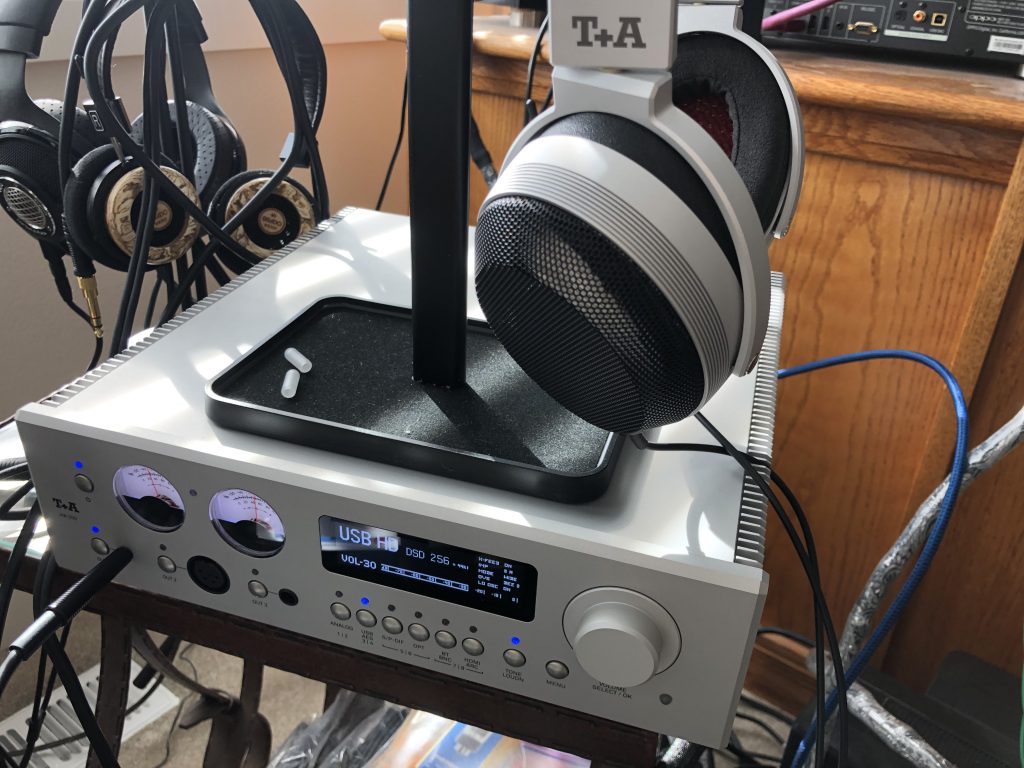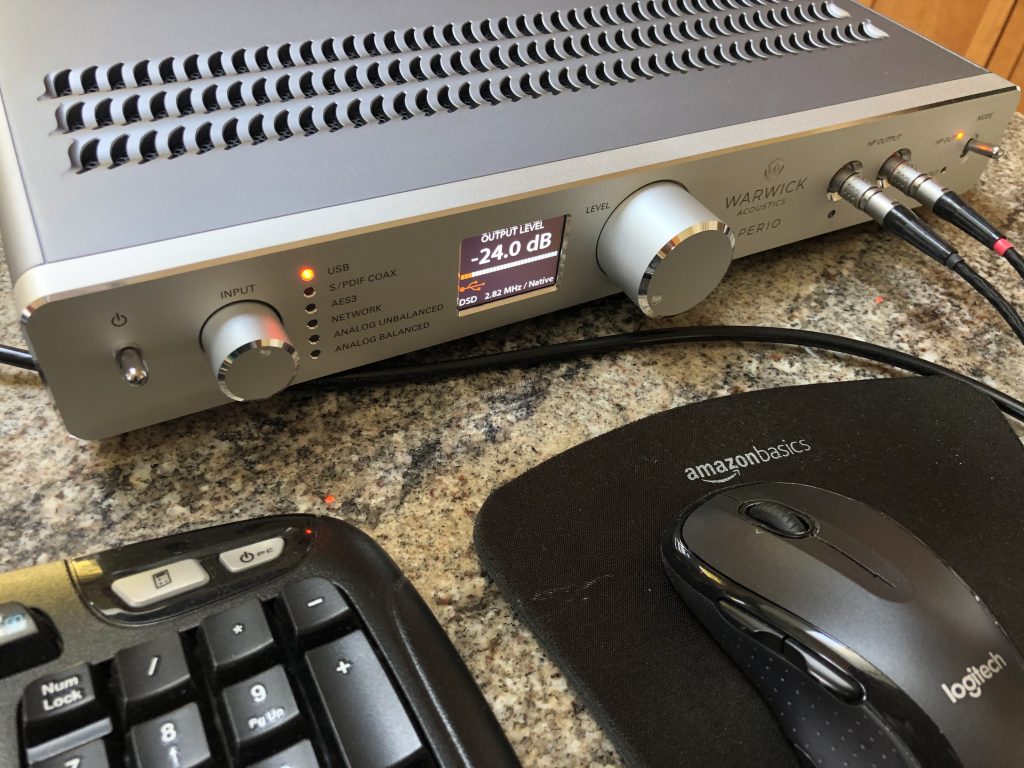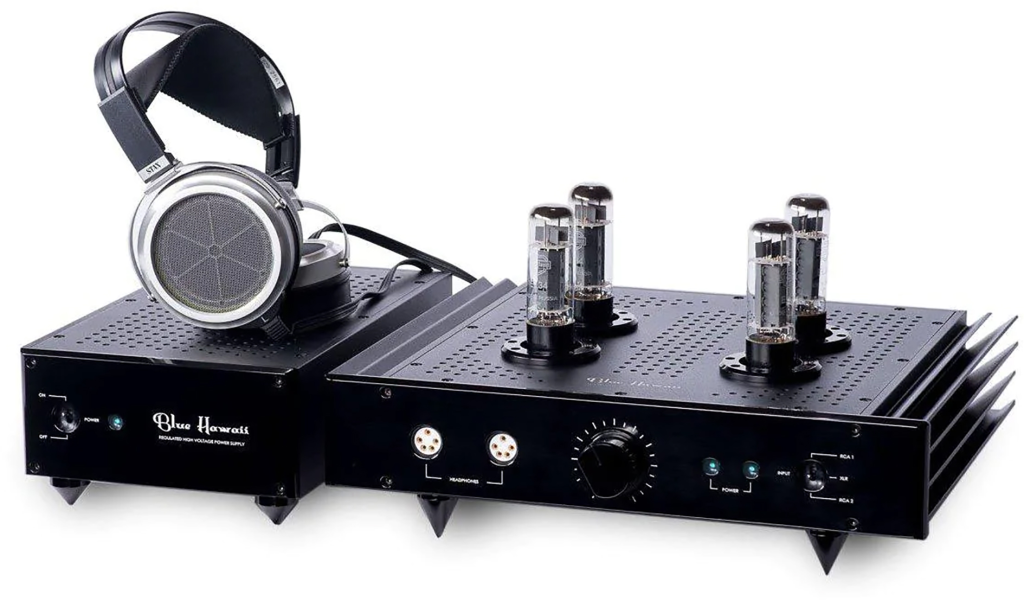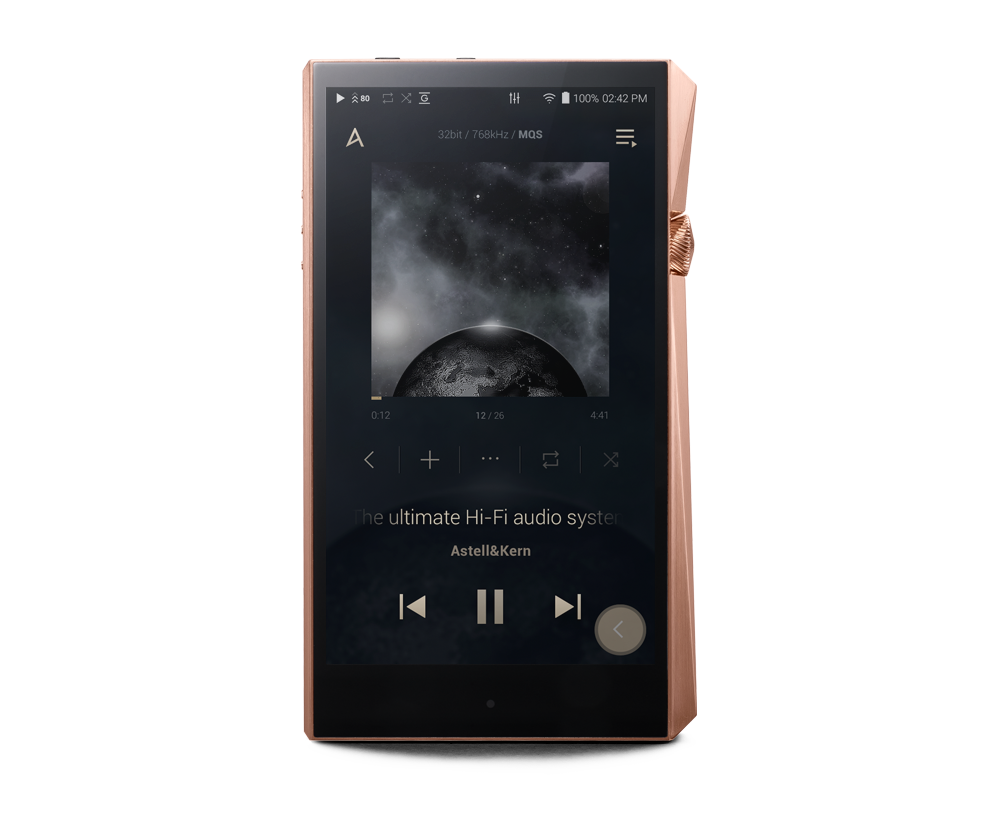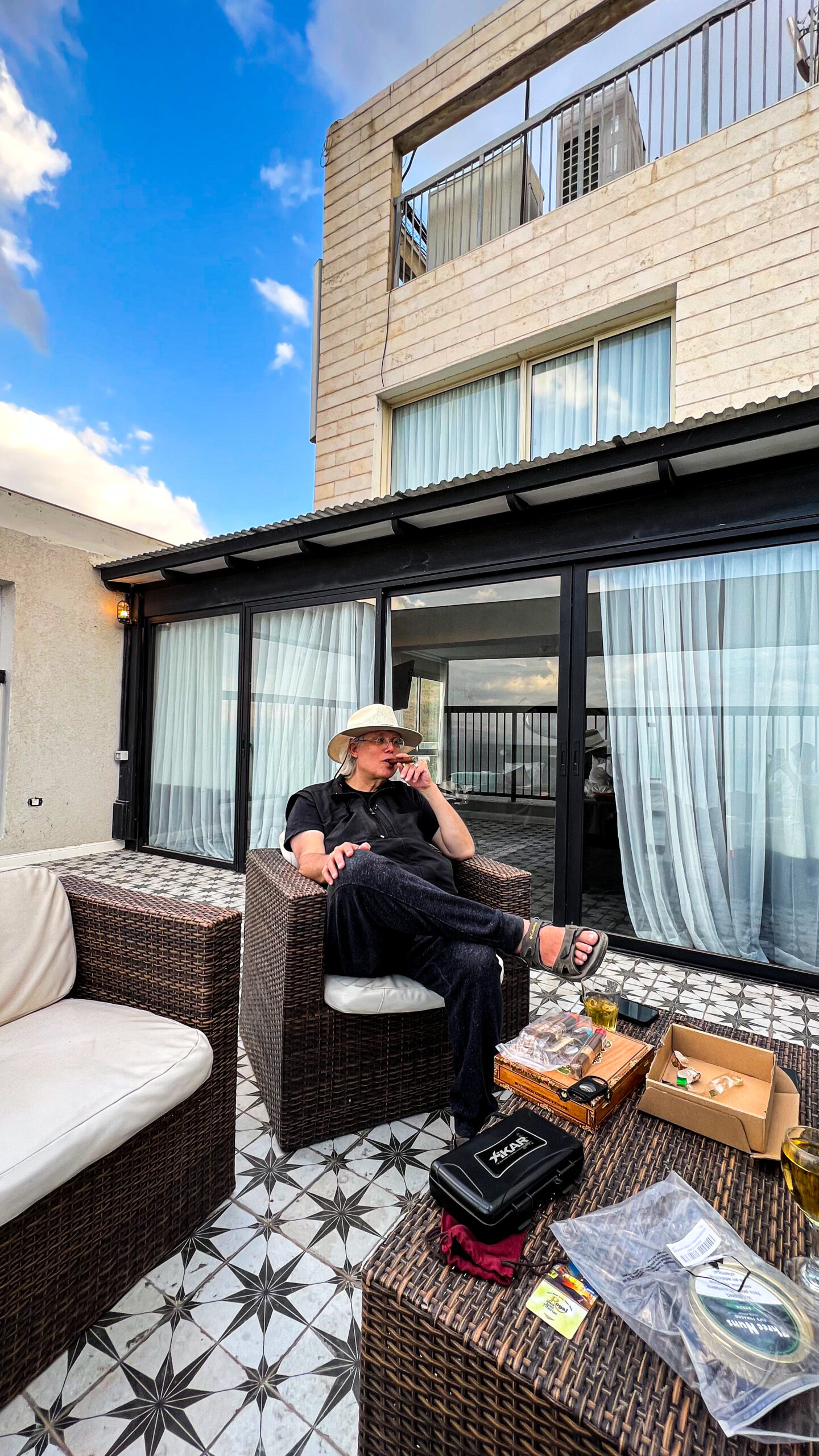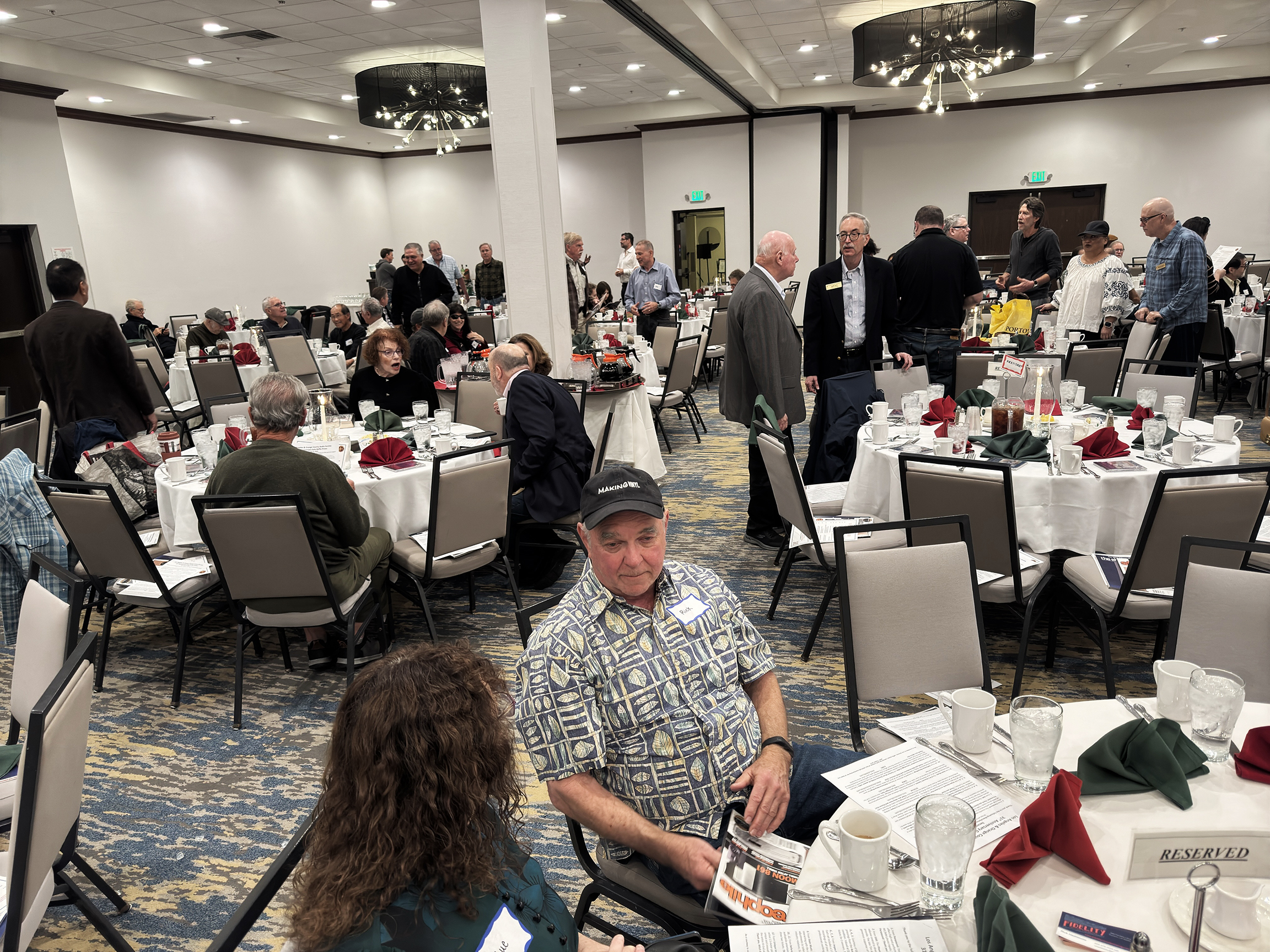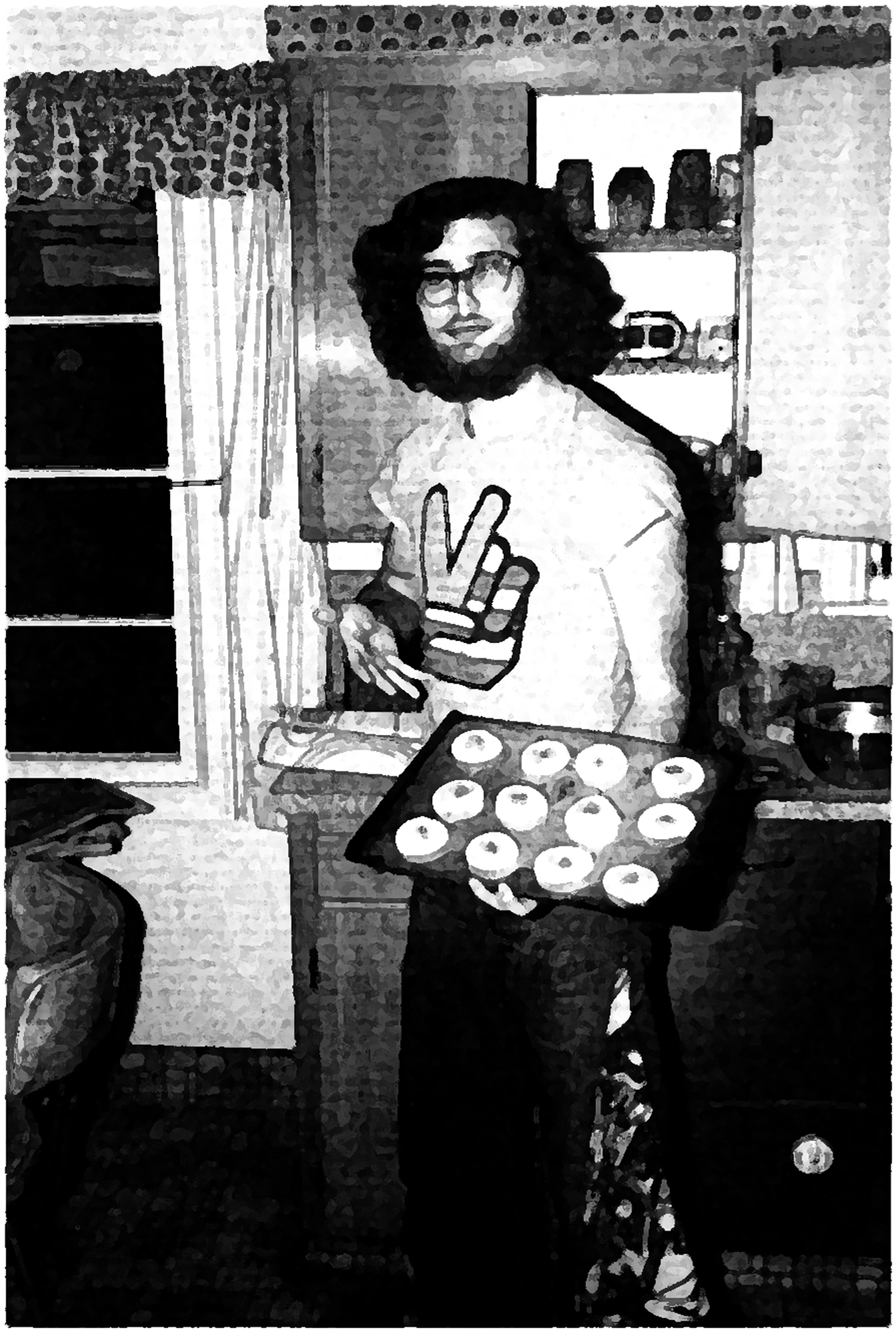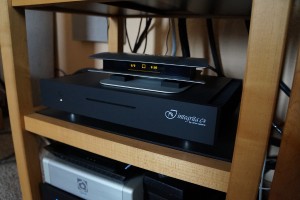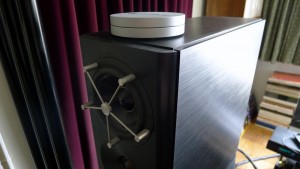The van den Hul Extender in place on top of the Evolution Acoustics MM2 Loudspeaker
From time to time I've roiled the tempestuous waters of high-end audio…rough enough already, without additional help from me…with favorable observations about my experiences with various system-enhancing components. Lord knows, I've patiently endured the shouting so-called "objectivists," who assert that whatever it is that I'm talking about cannot possibly work, cannot possibly have the effect that I document, cannot possibly be anything other than either self-delusion, evidence of corruption, or an incontrovertible testimony to the fact that I cannot possibly hear.
[Yawn.] I've heard it all, pretty much, and don't waste time engaging in arguments with such folks.
On the other hand, I also know that the designers of some products also suggest explanations or theoretical statements for their work that can push the edge of credibility, or explore strange new worlds of electronics/physics that cause even open minds to furrow their brows. New materials, out-at-the-edge effects, and hitherto unconsidered fields/forces make for some tough sledding when it comes to acceptance of the bases for such designs. I'm sympathetic to those who struggle, since some justifications may be highly speculative. Worse, there is always the possibility of the bogus, real scams, flim-flammery, bullshite artists, and the-innovation-that-really-isn't-new. A reasonable watchfulness is wise.
And yet: I would not wish for ground-breaking work to cease simply because there was skepticism or disbelief about proffered justifications for technical progress. Nor would I accept any stance to technical progress that rejected possibilities a priori, simply because they conflict with a person's worldview of what can or cannot be. That is mere close mindedness masquerading as "science," falsely so called.
The new van den Hul The Extender is one such product that pushes the edge. I first encountered it last year at a high-end audio show…AXPONA, 2017, it was...and had a chance to hear its effect in a room under show conditions. It's always challenging to be categorical about such a system-enhancing product in an unfamiliar room with a given system under show conditions, and what I was listening to was a prototype that doesn't look like the final product. Nevertheless, I definitely heard a beneficial result when The Extender was activated. I wanted to verify this under well-known conditions, though. That means home base, whenever feasible.
I was intrigued enough to tell the US distributor for van den Hul, Randy Forman of Finest Fidelity, that I would be willing to give it a go when it was in final form.
The Extender arrived towards the end of 2017, but it arrived with banana connectors which weren't compatible with the Evolution Acoustics MM2 with EXACT External Crossover. Van den Hul then sent out a different cable set with spade connectors which would work with the speaker posts on the MM2, and all was, at last, jake.
The van den Hul Extender, in situ
The final version of the Extender didn't look like the prototype at all. It's a solid wood frame compact box that rests on top of a speaker, with a power indicator, the company name, and nothing else on the front. The rear side has (from left to right) a signal input port, a Wave On switch, a power switch, and the input for an 18V DC power feed from AC. (There's a European plug on the AC adapter, but you also get a plug adapter for US receptacles.)
This is a really new product from van den Hul. As of press time, there was no manual available…I'm reviewing on the basis of emails from A. J. as passed along by Randy Forman. Also, there is no listing for this product yet on the van den Hul Web site, and so you'll be getting the best preliminary information that I have for this design. This will include some information from A. J. van den Hul himself.
Momentarily, that.
In setting up, I was told was to leave DIP switch 3 in the up position; the rest remain down for now. Done.
The Effect…
Normally, I might entitle this section "The Sound." None the worse for being a bit prosaic and pragmatic…but that doesn't cut it with the Extender.
Why not? Well, because the Extender is not a device that produces a sound, or affects the signal in some sort of direct pipeline sort of way. Certainly it is not a supertweeter; in fact, it isn't any sort of sonic transducer.
Lacking a manual, I have had to rely on email communication from A. J. van den Hul himself to explain what the Extender is about. Here are his comments, edited lightly for continuity.
"The Extender.
Listening to reproduced sound by any loudspeaker system in all kinds of listening situations made it clear to me that in the sound reproduction of a typical audio system, something essential was missing. That was the feeling of being really physically in the concert hall or jazz café.
The creation of The Extender was based on the search to find this "lost" live experience in any sound reproduction.
However, The Extender produces no sound-field, is therefore literary no super-tweeter. You cannot measure or hear any sound coming from The Extender.
The Extender emits a signal which communicates direct with the brain. Limited loudspeaker performance, colored acoustics, or even some ear defects are hereby bridged. These acoustical limitations in sound reproduction do therefore play no essential role anymore.
The sonic effect after connecting The Extenders is that the reproduced sound has suddenly natural space, depth, a very high definition, and an easy listening. You have the feeling you are facing the musical performance. You are "live" and "there," which was the aim for the creation of The Extender.
Just connect The Extender with its separate power-supply to the mains, and attached the supplied connecting cable with the binding posts of your loudspeaker system.
The 4-position dipswitch setting on the bottom is positioned for an average amplifier – loudspeaker combination.
Set always 1 position higher as the expected sound levels. [This comment is unclear to me.]
And enjoy afterwards a very realistic replay of your favorite music.
The best position is on top of the loudspeaker cabinet facing the listener. The opening angle of the emitted signal is 90 degrees."
As a further clarification, Randy Forman sent along a brief comment that A. J. sent to him to pass along to me: "Just got off the phone with AJ. The name of the signal that The Extender produces is called Scalar Waves, as pioneered by Tesla." van den Hul also wanted to mention that his technical assistant, Mr. Juergen Ultee, played an important role in developing the Scalar Wave concept in The Extender.
Elsewhere, A.J. refers to his use of "Torsion Field Technology" with The Extender, as mentioned by Peter Familare in Australia's stereonet article HERE.
Well now. Scalar waves are quite controversial in the world of physics, as some simple online research indicates when you use "scalar waves" as the keywords for some Google probing. I won't go through summarizing the concept, commonly tied in history to geniuses like Maxwell and particularly Tesla. The arguments of science vs. "pseudo-science," claims of suppressed truth and the alleged conspiracies thereof, and name-calling smack of a high-end audio discussion boards, with all the bile and vomiting that goes along with it.
Which is why I swore off audio discussion boards many years ago.
On the other hand, this is A. J. van den Hul himself, designing an audio product based upon his extensive experience in physics and electronics. From his self-description at the Science 2.0 Web site (http://www.science20.com/profile/aalt_jouk_van_den_hul):
ABOUT AALT JOUK
Born in 1937. Studied at T.U. Delft. Worked several years on a proton accelerator. Have been involved in teaching (Physics, Chemistry, Optics & Communication technology) for 13 years, also worked as technical journalist for 13 years. My company specialized in metal & non-metal conductors. Latest activity further specialization and business in Aramid, Basalt, Carbon and Dyneema Fibres and Weaves. Hobby indoor: Building phono-cartridges. Hobby outdoor: Cycling with sons. Biggest commitment: Top quality sound reproduction in the finest details.
(Further: As I recall, van den Hul has at least one PhD in some area of physics. I have asked him if he can supply me with a summary of his advanced/terminal degrees. If he sends them to me, I'll share them with you in a later revision of this essay.)
Leaving the yelling and screaming aside, clearly van den Hul has based The Extender upon a method for projecting Scalar Waves directly at the listener in a manner tied to loudspeaker signals that are being generated at any given moment. This is radically revolutionary and outside the main boundaries of thought in physics, in that supporters of the existence of Scalar Waves assert that they act outside of the usual realm of electromagnetic fields, penetrating even to the interface of the space-time continuum. Much of the online material about Scalar Waves seems to diffuse into the mystical rather directly. (Not that such speculation is unknown to high-end audio, nor that such mystical experience/speculation is invalid. Modern physics is a realm filled with speculation, very high strangeness, and…yes…even mysticism.)
Rear view of The Extender
Let's accept Scalar Waves as van den Hul's framework, hold the proffered explanation in a willing suspension of disbelief, and evaluate the effect. High-end audio ought to be quite empirical, though there are those who seem to think that fine audio is a theoretical realm.
The Extender is certainly easy to use; in the photograph above, you see the back of the review sample. (Notice that the DIP switches are set to the default input sensitivity, which is switch 3 on. Without further documentation from van den Hul, I left it there as the recommended starting point.) Once all is hooked up, you simply power up the unit, and then set the "Wave On" switch upwards. That's it.
Rear view of The Extender resting on top of the Evolution Acoustics MM2 with EXACT External Crossover. The yellow cable is the van den Hul signal cable for The Extender. The large twisted cables are the Synergistic Research Galileo UEF; the thin black cables are the Synergistic Research wires for their Active Ground SE system.
And what effect does it have?
This takes some effort to qualify. There is something quite real here to my ears, but describing it in a way that conveys what I hear and feel is challenging. Bear with me.
Using LP, DSD, and SACD sources, what I can say is that I have been able to confirm a definite difference between our current reference system without The Extender in operation, and then with it. A/B/A/B/A switching, non-blind listening…the effect is an improvement in the performance of the system. And our current setup is already at a level of very high resolution, without the loss of musicality.
The nature of the improvement is quite interesting to me. For one thing, I immediately noticed a deepening of the soundstage…a soundstage that was already remarkable, given the components in play already. (For example, the Synergistic Research Atmosphere XL4 with ATM, personally set up by Ted Denney III himself, uses user-selectable sound-space profiles to deal with RF fields in your listening room. The SR site states that "Atmosphere is a two-channel, multi-wave RF field generator with the power to transport you to the live event." Its effect is directly electromagnetic, not sonic, acting at an RF field level. For my comments on the SR Atmosphere XL4 in part one of my 2017 Brutus Awards, see HERE.)
Interestingly enough, The Extender further increased the depth of the sound field, taking the XL4's endpoint as a stepping-off launch pad for the further unfolding of the acoustical field. I could feel as well as hear the effect, as it telescoped outwards from approximately midfield onwards with the flip of the field switch. It was strange…in visual equivalency, almost like watching Hitchcock do a dolly zoom in Vertigo, or Steven Spielberg do his variation of same in homage to Hitch in Jaws. On and off went the switch; here and gone went the effect. The XL4 and The Extender were nearly symbiotic in their combined impact: one acting at the electromagnetic RF level, the other presumably projecting its Scalar Wave connection to the listener directly. Synergistic; even symbiotic, these two.
Remarkable.
Furthermore, the sense of detail increased when The Extender was active. More subtle elements and more texture were evident, regardless of source type. The result was improved imaging, with a more definite placement of instruments and voices. So the combination of telescoping soundstaging and more precise imaging are what led to the dolly zoom feel as I listened. I have to say that I've never quite experienced this sort of step forward before. It's unique.
Finally, I should say that there's a feeling that goes along with using The Extender. There's a sense of connection to the recording…to the music…that relaxed me inexplicably. I usually qualify this in my writing as an ease, the natural cessation from tension that occurs when we're approaching the musical/audio thing itself. When you're in the groove…when you're in the zone…but those are usually passing moments, in the midst of good mojo set of components with a particularly congenial recording.
With The Extender, the emotional connection to the music, the growing sense of ease, just kept on coming. As long as it was operating, all was mellow; as soon as I turned it off…even in the middle of a great tune or movement…there was a sense of loss.
So, there it is. Whatever it is. It's there, it's real, and even if the explanation for the Scalar Wave field that A.J. van den Hul offers would take quite a while to think through, and is controversial as hell, it remains. Res ipsa loquitur.
The Extender pushes high-end audio further into the world of the fields in which "…we live, and move, and have our being." The more we know, the more the universe becomes a stranger and stranger place. Sitting in my GamuT Lobster Chair, and listening to the sound field morph before my listening ears, reaching the conclusion that I would really feel the loss of The Extender, is a very bemusing thing.
Scalar Waves. (Are they really being tested as a weapon?) Torsion Fields. (Are the USA and Russia really researching this somewhere under the sheets?) Can my perception of recorded music really be affected by non-audio, non-electromagnetic signals being beamed directly at me, resonating in my brain and body as my sensorium?
A.J. van den Hul seems to be saying "Yes!"
Me, I'd love to sit down with him over drinks and talk about this for a few hours.
As for you, dear reader, about all that I can say is that I'm hearing something important here at home base. You will have to audition The Extender at an audio show if you can, and see what you make of it. If you have a budget that can try these, I think you'll find that you could spend more money to less effect than investing in van den Hul's The Extender.
I do know that as long as I have The Extender here, I won't be doing any listening in our reference stereo room without them….
Price: USD $4995 per pair
van den Hul
(A word to our readers: the van den Hul Web site is out of date, in some cases by several years. You won't be finding a product listing for The Extender there yet, unfortunately. I have communicated the need for a Web site update; meanwhile, contact Randy Forman, the US distributor below, for information or to place an order. Elsewhere in the world will have to contact van den Hul in Europe, or their distributor/dealer for The Extender.)
US Distributor
Randy Forman, Finest Fidelity
3 Sagebrook Drive
Bluffton, SC 29910
386.341.9103
Images by David W. Robinson; drawings by Dan Zimmerman.




